News 2013
Dec 11, 2013: CO2 Conference Week. Susan Hovorka presented "Monitoring for Storage (Assurance)" and Rebecca Smyth presented "Monitoring CO2: The Quest for a Clean Signal (Case Studies)" as part of a Short Course on Surveillance and Monitoring of CO2 Injection Projects. Midland, TX,
December 9, 2013: CO2 Conference Week. Susan Hovorka presented "Demonstrating CO2 storage" at the 11th Annual EOR Carbon Management Workshop. Midland, TX,
November 19-21, 2013: CO2 for EOR as CCUS. Vanessa Nunez presented "CO2 Storage, Monitoring, Verification, and Accounting" at this collaborative symposium on CO2-EOR between universities in Texas and Norway, the oil industry in Texas and Norway, and other CO2-EOR stakeholders. The symposium is an initiative of the Petroleum Research School of Norway, NorTex Petroleum Cluster. It is sponsored by Norway's Ministry of Petroleum and Energy, the International Energy Agency, the US DOE, and the Norwegian Research Council and co-hosted by the Royal Norwegian Consulate General. Houston, TX
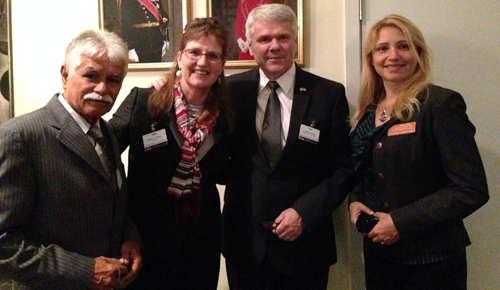
Petronio Nuñez, Hilary Olson, Norway's Consul General Jostein Mykletun, and Vanessa Nuñez at the Consul General's residence.
November 5-6, 2013: British Geological Survey and University of Edinburgh. Tip Meckel participated in discussions related to a proposal for an IODP drilling leg in the North Sea being proposed jointly by researchers from Norway and the UK. The proposal will focus on the Quaternary glacial history and implications for CCS. These topics are linked via vertical isostacy related to deglaciations, resulting overpressure and seal integrity, and depositional systems related to both storage targets and the overburden. Meckel was hosted by Stuart Haszeldine of Scottish Carbon Capture and Storage, as well as Gareth Johnson of the University of Edinburgh. Edinburgh, Scotland
November 4-6, 2013: CSLF Side Meeting. Ramon Trevino and Katherine Romanak hosted a side-meeting during the Carbon Sequestration Leadership Forum's Ministerial to discuss an international collaboration on subsea CO2 geological sequestration. Topics included barriers to offshore GS implementation; advantages of sharing experience, cost, risk and technology; scaling-up issues; and variability in feasibility in different countries. Washington, DC.
October 29-30, 2013: IEAGHG-OPEC Workshop on CCS as CDM. GCCC was invited to participate in a workshop hosted by OPEC secretariat with the goal of introducing government and industrial participants from OPEC member countries to CCS. Topics included ways to developing Clean Development Mechanism (CDM) projects that use CCS. Since the adoption of CCS as a CDM, it has stimulated over 7000 low-carbon projects in developing countries, representing over 2,000 Mt of CO2 reductions. For more information, please click here. Vienna, Austria
October 29-30, 2013: IEAGHG-OPEC Workshop on CCs in the UNFCCC Clean Development Mechanism. Katherine Romanak gave the lecture, "Monitoring and Environmental Aspects of CCS" and also served as an expert mentor for group work on how to develop CCS projects for the Clean Development Mechanism under the new rules and procedures. For more on the meeting, please see IEAGHG blog by Tim Dixon. Vienna, Australia
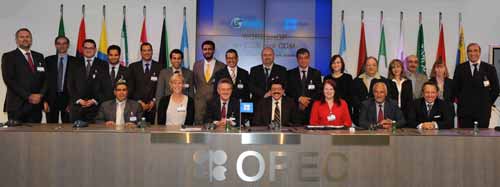
Katherine Romanak, front row, second from left, participated in CCS for CDM workshop.
October 28, 2013: International Journal of Greenhouse Gas Technologies. Alex Sun and JP Nicot, along with Xiaodong Zhang published new work on monitoring at CCS sites, "Optimal design of pressure-based, leakage detection monitoring networks for geologic carbon sequestration repositories." http://dx.doi.org/10.1016/j.ijggc.2013.09.005
October 2013: New High-Resolution Seismic Survey in Gulf of Mexico. A second 3D seismic survey using the new P-Cable acquisition system was successfully completed during ten days of data collection off the Texas coast in October. The system, which includes dense data collection from 12 streamers and 96 channels, is designed to provide extremely high-resolution 3D data for relatively shallow stratigraphic depths (<1500 m). The BEG is the only research institution in the United States currently operating such a P-Cable seismic acquisition system. GCCC's Tip Meckel led the survey and Ramon Trevino led the logistical coordination from shore. Participants included BEG's Dallas Dunlap, Nathan Bangs from the Institute for Geophysics, and Ben Phrampus, a graduate student from SMU.
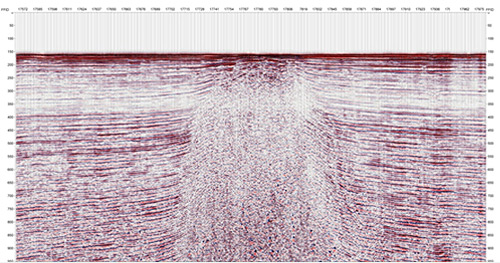
A single-channel field record from the recent survey shows a salt dome approaching the seafloor in the center part of the survey.
During the October cruise over 400 line-km were shot in an area offshore southern Galveston Island adjacent to and including portions of the San Luis Pass shallow salt dome. The survey imaged subsurface stratigraphy and structure above a Miocene-age CO2 storage prospect at ~2,000 m depth. The data will be analyzed to understand geologic seal and fluid systems. Interest from industry in a subsea carbon storage repository has been building, and acquiring datasets such as those collected using the P-cable system are important for developing a variety of commercial applications of high-resolution 3D technologies.
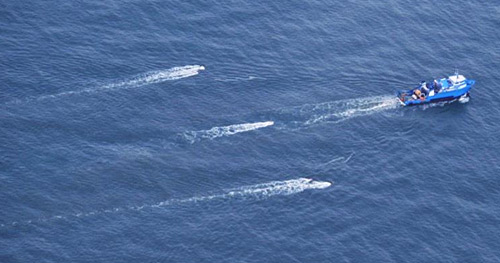
The R/V Brooks-McCall, approximately 50 m in length, tows the P-cable system in October 2013 in the Gulf of Mexico. Photo courtesy of TDI-Brooks International.
The survey was performed from the R/V Brooks McCall based out of Freeport, TX, and operated by TDI-Brooks International, Inc. of College Station. NCS Subsea provided navigation support. The research cruise was funded through DOE-NETL's carbon sequestration research program and the Texas General Land Office as part of a multi-year effort to characterize potential CO2 storage sites in the near-offshore Gulf of Mexico.
BEG's first P-Cable survey in the San Luis Pass region was completed in July 2012. Data processing of both surveys is ongoing and one more GOM acquisition survey is planned for 2014.
Read more reporting on the survey. Learn about the BEG's first P-Cable acquisition cruise.
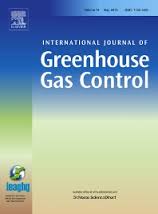
October 24, 2013: Special Issue on Cranfield Marks a Milestone
A special section of the October issue of the International Journal of Greenhouse Gas Control is dedicated to CCS work at Cranfield Field, Mississippi. The section comprises a mid-project overview and assessment of the CCS field work, dense data collection, and analysis that began a decade ago with the formation of the Southeast Regional Carbon Sequestration Partnership and that continues today at Cranfield Field. The section consists of sixteen papers authored by GCCC staff and their colleagues. It opens with a discussion of the Cranfield project design and covers risk assessment, characterization, injection and production activities, as well as monitoring techniques and modeling.
The publication of this collection of papers is a gratifying milestone for the GCCC. The volume was guest-edited by Susan Hovorka, Tip Meckel and JP Nicot. Nicot commented, "This is the first exhaustive document of the Partnership's projects, and it will be useful to the entire CCS community."
October 22, 2013: Visit to GCCC by Tim Dixon. Tim Dixon from the University of Miami spoke with GCCC staff about surface deformation as a tool to track pressure increase in the subsurface. Austin, TX
Seunghee Kim, Seyyed Hosseini, and Tim Dixon discuss using geodesy for CO2 monitoring.
October 11, 2013: Kit Caruthers from the University of Edinburgh presented "Investigation of Environmental Impacts of UK Offshore CO2 Storage" at the GCCC weekly meeting. Austin, TX
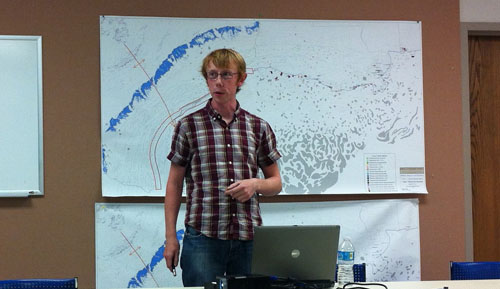
Ph.D. candidate Kit Caruthers from Scotland is working with GCCC staff on aspects of his research investigating natural analogs.
October 10, 2013: Congratulations to Seunghee Kim, Seyyed A. Hosseini, and Susan Hovorka for receiving the award for the Best Paper for "Numerical simulation: Field scale fluid injection to a porous layer in relevance to CO2 geological storage" at the COMSOL conference. The meeting is the premier event for multiphysics modeling and simulation. Boston, MA
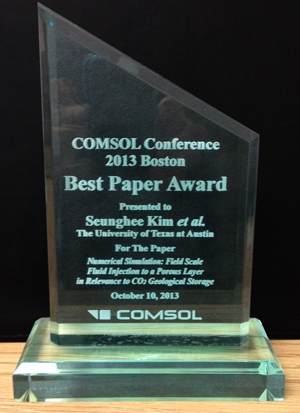
GCCC Post Doc Seunghee Kim presented award-winning work on CCS.
October 1, 2013: "Greensites and brownsites: Implications for CO2 sequestration characterization, risk assessment, and monitoring" was authored by Brad Wolaver, Susan Hovorka, and Becky Smyth and published in the International Journal of Greenhouse Gas Control. The paper characterizes differences between sites lacking previous subsurface development, or greensites, and sites where the subsurface has been developed, or brownsites, as they pertain to CO2 injection for storage and for EOR. Greensites are typically more stable, and thus a simpler environment for characterization and monitoring, while at brownsites legacy infrastructure and contamination must be evaluated so that leakage signals are not mimicked or masked. These differences should be recognized in policies and regulations.
September 10, 2013: A new letter comparing several cases for understanding the economic viability of capturing large quantities of anthropogenic CO2 from coal-fired power generators within the ERCOT electric grid and using it for pure CO2 enhanced oil recovery (EOR) in the onshore coastal region of Texas along the Gulf of Mexico has been authored by Cary King, Gürcan Gülen,Stuart Cohen, and Vanessa Nuñez-Lopez and published in Environmental Research Letters. The entire paper, titled "The system-wide economics of a carbon dioxide capture, utilization, and storage network: Texas Gulf Coast with pure CO2-EOR flood," can be found here: http://stacks.iop.org/1748-9326/8/034030
August 28-November 6, 2013: Global CCS Institute's Capacity Development Program for Mexico. Vanessa Nunez will present a series of webinars as a follow-up to a week-long 'train-the-trainer' course conducted in February for professors and lecturers from geology departments at four universities. The webinars will be given in Spanish and translated into English. Topics include: Methodologies and guidelines for selection of storage sites in saline aquifers; Fundamentals of modelling CO2 movement underground; and Fundamentals of monitoring CO2 injected underground. For recordings and browsable versions of the webinar, please click here. Austin, TX, Mexico City, and Canberra, Australia
August 26-30, 2013: IEAGHG Monitoring Network and Environmental Research Network Combined Meeting-Realistic Monitoring of CO2 Migration: From the Reservoir to the Surface.Katherine Romanak presented "Insights into CO2 migration from non-CCS perspectives" and "Detection of signal over hydrocarbon-induced noise at Cranfield." Romanak also chaired a session "Detection of Leakage into Shallow Groundwater." Susan Hovorka presented "Mapping the plume: What do regulators need to require?", "Value of airborne conductivity and magnetics for CCS: Test case at Cranfield," and "Site-specific tool sensitivity." Hovorka also chaired a session, "Monitoring migration from the reservoir." Sean Porse presented "Monitoring in the overburden: Is pressure or geochemistry a better indicator of leakage?" Canberra, Australia

Katherine Romanak, Sue Hovorka, and Sean Porse visit the Ginninderra controlled release site during the IEAGHG meeting.
August 20-22, 2013:Carbon Storage R&D Project Review Meeting. Ramon Trevino presented "Gulf of Mexico Miocene CO2 Site Characterization Mega Transect—2013 Update." Alex Sun presented, "Enhanced Analytical Simulation Tool (EASiTool) for CO2 Storage Capacity Estimation and Uncertainty Quantification." Ian Duncan presented, "Developing a Comprehensive Risk Assessment Framework for Geological Storage of CO2." Susan Hovorka and Changbing Yang also attended. Pittsburgh, PA
August 14-16, 2013: Coal-Gen 2013. Carey King is part of a panel discussion, "Coal's Savior: Capture and Sequestration?" His presentation is, "System Economics of Texas CCUS Network and Internalizing CO2 Emissions." Charlotte, North Carolina
July 9, 2013: The Role of Computation in Protecting the Environment. The goal of the workshop for high school students was explore the emerging interdisciplinary role of mathematics and computational science in the simulation and solution of the Grand Challenge of carbon sequestration. It included discussions on laboratory and field experiments, mathematical modeling and large-scale parallel computation as applied to the environmentally important carbon storage problem. Ramon Treviño and Hilary Olson presented a talk on Core analysis and storage.Katherine Romanak discussed Monitoring CO2 injection by Skype from the field. The program was hosted by NSF, CDI, CSM, ICES, BEG, STORE, DOE, and GCCC. Austin, TX
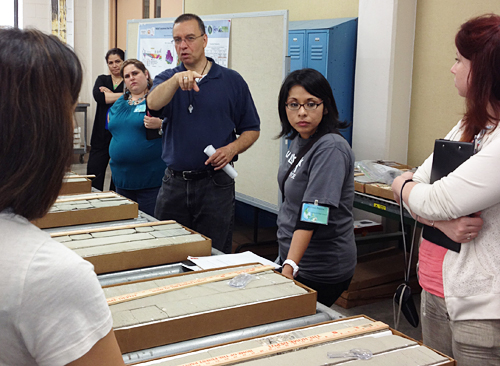
Ramon Treviño leads a group of high school students on a tour of the core facility at BEG.
July 8-9, 2013: Tensleep III - ROZ & CO2. Logan West was invited to the discussion-based workshop, which included topics such as residual oil zone and enhanced oil recovery. Caspar, WY

July 7, 2013: The West Texas Geological Society (WTGS) awarded the John Emery Adams Scholarship in the amount of $2000 to MS candidate Logan West. WTGS writes that through this scholarship they are delighted to continue to support and promote the geosciences at the University of Texas at Austin. Congratulations to Logan!
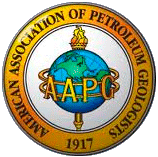
July 2, 2013: Accolades for GCCC from the American Association of Petroleum Geologists Division of Environmental Geosciences!
At the AAPG Annual Convention and Exhibition in May, Tip Meckel presented, "Determining Seal Effectiveness and Potential Buoyant Fluid Migration Pathways using Shallow High-resolution 3D Seimic Imaging: Application for CO2 Storage Assessment on the Inner Texas Shelf." This oral presentation was selected as the Bernold M. "Bruno" Hanson DEG Excellence of Presentation award (best paper).
The poster Marlo Gawey presented, "Experimental Analysis and Modeling of PFT and SF6 Transport in Organic Rich Vadose Zones: Implications for Monitoring CO2 Leakage at CCS Sites" was selected as the as one of the two Division of Environmental Geosciences Best Poster Awards.
Both awards will be presented in a special ceremony during the DEG luncheon at the 2014 AAPG Annual Convention April 2014 in Houston, Texas. Congratulations to our winners!
June 24-28, 2013: Repetitive Pulse Monitoring Approach Tested. Seyyed Hosseini designed and tested a novel approach for monitoring the CO2 presence in above zone monitoring intervals in a Gulf Coast region CO2-EOR oil field south of Houston. This approach is based on repetitive pulse testing between two or more wells perforated in the monitoring sands to assess the change in compressibility of the formation over the time, a sign of possible CO2 leakage from deeper zones.
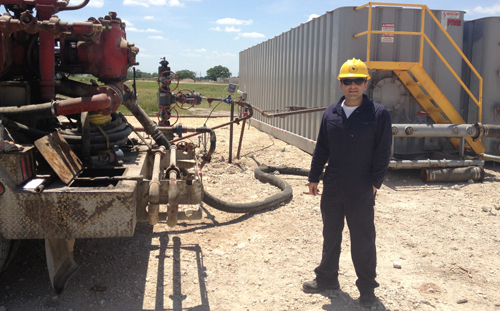
Hosseini at the CO2 test site on the Gulf Coast
June 24-26, 2013: American Geophysical Union's Science Policy Conference Sean Porse presented "Using Analytical and Numerical Modeling to Assess Groundwater Monitoring Parameters at Carbon Capture, Utilization, and Storage Sites." Workshop sessions focused on three major topics: Energy, Hazards, and the Arctic. The conference was an opportunity for Porse to present his own research and to collaborate with scientists from a broad range of backgrounds including government and academia, as well as with congressional representatives and staff. Washington D.C.
June 19-20, 2013: Strategic storage Resource management IEAGHG, GCCSI, and BGS Workshop. Susan Hovorka was invited to give a talk "Stacked Storage" at the meeting held at the British Geological Survey, Keyworth, Nottingham, UK
June 13, 2013: EarthLabs, Confronting the Challenges of Climate Literacy. GCCC ran a workshop as part of an online course called Climate and the Carbon Cycle developed by Earthlabs. Thirty to forty participants had the opportunity to tour the pilot CO2 capture research facility, the core viewing room, and hear to presentations by GCCC staff on geologic site characterization, subsea geologic storage, enhanced oil recovery, environmental monitoring, and storage capacity. Tip Meckel and HiIary Olson organized the workshop. Austin, TX
June 11-12, 2013: Workshop: Introduction to Carbon Dioxide Enhanced Oil Recovery (CO2-EOR). Susan Hovorka was invited to give a talk comparing green storage sites and brown sites during a session addressing CO2 storage through EOR. She compared green and brown sites. The workshop was organized by the Center for Climate and Energy Solutions, Permian CCUS Center, and the Railroad Commission of Texas. Houston, TX
June 9-14, 2013: The 14th Water-Rock Interaction Conference. Katherine Romanak presented, "Potential for a process based monitoring method above geologic carbon storage sites using dissolved gases in freshwater aquifers." Avignon, France
June 7, 2013: Much research has addressed the flow of CO2 driven by pressure gradients such as occur near injection wells. Less attention has been paid to the flow conditions of CO2 far from injection wells where pressure gradients are reduced and flow is dominated by buoyancy and capillarity. A recent publication in the Journal of Sedimentary Research by GCCC researcher Tip Meckel addresses the complexities that small scale depositional heterogeneity of rock properties (permeability and capillary entry pressure) can have on flow migration pathways driven by buoyancy. The paper reinforces the importance of local capillary trapping. Flow moves in extremely narrow pathways with dense saturation, but bulk rock saturations remain low. Understanding this flow regime is important for appreciating CO2 migration potential, capacity, and also for monitoring aspects such as seismic imaging at plume margins. For a link to the paper, titled "Digital Rendering of Sedimentary-Relief Peels: Implications for Clastic Facies Characterization and Fluid Flow," please see: http://jsedres.sepmonline.org/content/83/6/495
June 5, 2013: CCUS Conference Presentation Winner! Participants in the 12th Annual Conference on Carbon Capture Utilization & Sequestration held in Pittsburgh in May were asked to vote for presentations that they felt were the "most ground breaking, innovative and insightful." Many outstanding presentations were submitted, but the winner was Katherine Romanak for her talk, "Protocol for Response to Claims of CO2 Leakage: Case Study at the Kerr Farm, Weyburn-Midale Oilfield." She claims an iPad for her outstanding work. Congratulations, Katherine!
June 4-6, 2013: 7th Trondheim CCS Conference. Katherine Romanak presented "Protocol for Response to Claims of CO2 Leakage: Case Study at the Kerr Farm, Weyburn-Midale Oilfield" Trondheim, Norway
May 31, 2013: Pacific Northwest National Lab. Susan Hovorka visited and discussed a number of possible areas of collaboration. Redmond, WA
May 13 - 16, 2013: 12th Annual Conference onCarbon Capture Utilization & Sequestration. Susan Hovorka presented: "SECARB Cranfield project: update after four years injections with four million metric tons stored" with co-authors JP NIcot and Katherine Romanak and "Role of Pre-injection Baseline for CCUS" with co-authors Ramon Trevino and Seyyed Hosseini. Brad Wolaver presented "Greensite vs. brownsite monitoring: implications for CCUS." Katherine Romanak presented "Protocol for response to claims of CO2 leakage: case study at the Kerr Farm, Weyburn-Midale oilfield." Mehdi Zeidouni presented a poster "Analytical model of leakage through fault to overlying formations." Logan West attended. Pittsburgh, Pennsylvania
April 24-25, 2013: 14th Annual MIT Carbon Sequestration Forum. Susan Hovorka gives a presentation in a session titled "Induced Seismicity and Leakage Risk in Large-scale CO2 Storage." Cambridge, MA
April 18, 2013: Carbon Sequestration Leadership Forum CO2 Monitoring Interactive Workshop.Susan Hovorka attends, representing the CSLF-recognized SECARB Early Test at Cranfield. Rome, Italy
April 13, 2013: GirlTalk: Conversations on Energy, Climate and Water. Rebecca Smyth and Katherine Romanak facilitated a half-day workshop with 5th-8th grade girls from St. Gabriel's Catholic School. STORE Director Hilary Olson, who is the co-founder of GirlTalk, explains that "recent studies indicate that relevance, or the impression that a job is rewarding and 'for me', is a major motivating factor as girls consider science, technology, engineering and math careers. GirlTalk is an invitation to girls to consider the rewards of exciting careers that address some of the most important issues of this century: energy and water resources, and our changing climate." The workshop features "Breakfast with a Pro," hands-on workshop sessions, and a panel discussion. Austin, TX
April 9, 2013: Tip Meckel presented an overview of CCS to an undergraduate course in UT's Petroleum Systems and Geoengineering program. A link to the video is here.
April 5, 2013: South Central Section of the Geological Society of America Half-day Workshop for Educators. Teachers from across the US joined GCCC staff at the Pickle Campus for a field trip "Carbon Capture and Geologic Storage: Global Research Centered in Texas." Activities included tour of the amine pilot plant capture facility. the core research center, and environmental monitoring lab. Discussion covered basics of CCS, subsea geologic storage and environmental monitoring. GCCC thanks Eric Chen, Tip Meckel, and Changbing Yang for providing fascinating and unique perspectives on CCS. Thanks also to Ramon Trevino and Zahid Kandakar, as well as CRC and Bureau support staff for making the field trip run so smoothly. Austin, TX.
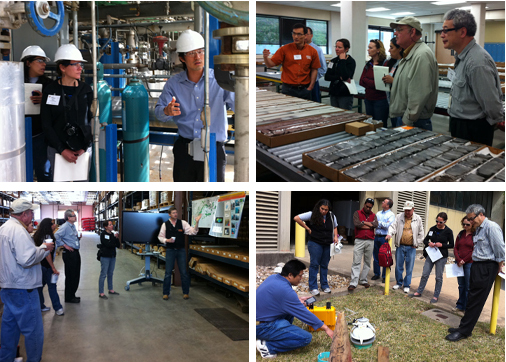
GCCC staff cover a variety of CCS topics during half-day field trip for educators attending GSA.
April 1-4, 2013: 1st Course Advanced Topics in Carbon Capture and Storage. Vanessa Nunez gave a lecture "CO2 monitoring in EOR projects" in the course, which was sponsored by The Center of Excellence in Research and Innovation in Petroleum, Mineral Resources and Carbon Storage (CEPAC) and the Carbon Sequestration Leadership Forum (CSLF). Eighty students including both undergraduate and graduate university students, and also Petrobras employees and the public attended. Speakers included a variety of international researchers such as those from DOE and TNO, the largest research institute in The Netherlands. The course was held at Pontifical Catholic University of Rio Grande do Sul. Porto Alegre, Brazil
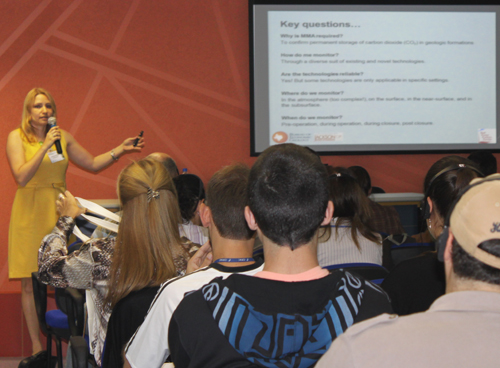
Vanessa Nunez discusses monitoring for EOR
March 15-16, 2013: 3rd Annual Korean CCS conference. Susan Hovorka gave a talk, "Update on US geologic storage tests: defining a fit-to-purpose monitoring program." Jeju Island, Jeju city, Korea
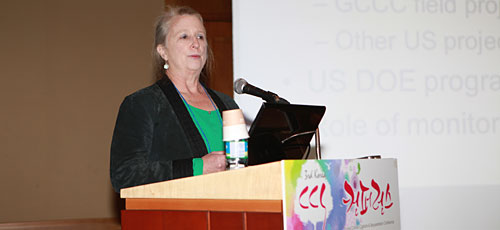
Susan Hovorka provides a review of geologic storage sites.
March 6, 2013: Very Susanto, visiting researcher from Kyushu University in Japan presented results from his work on gas migration conducted at the Ito Natural Analogue Test Field Project for CO2 Geological Storage. Austin, TX
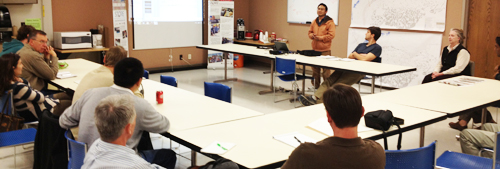
Very Susanto, nearest to screen, discusses possible tracers that could be used for monitoring with GCCC staff.
March 4-6, 2013: University of South Florida (USF) graduate student Makan Abdollahzadeh Karegar, who works with Tim Dixon and Rocco Malservisi in the Department of Geology, USF, visited GCCC to work with Seyyed Hosseini. Makan is investigating the surface deformation at the Hasting, Texas EOR site operated by Denbury Resources, associated with reservoir pressure changes due to variable rates of injection of CO2 and saline water, and extraction of oil. Preliminary results suggest a high degree of correlation between surface deformation, as measured by high precision GPS, and changes in reservoir pressure. Over the next year, the USF group hopes to develop a quantitative model that relates the two parameters, incorporating the known stratigraphy and rheology of the reservoir and overlying rocks. Austin, TX
March 4, 2013: 8th Annual SECARB Stakeholders Briefing. Changbing Yang presented results of groundwater monitoring at Cranfield and implications for other CCUS sites. www.secarbon.org Atlanta, Georgia.
March 2, 2013: Explore UT. GCCC asked kids spending the day exploring The University of Texas at Austin to consider "What To Do with CO2: Cures for the Feverish Earth." Interactive activities presented by staff and students included building models of carbon dioxide, floating balloons on a bed of invisible carbon dioxide, and exploring a magnified model of reservoir pore space.
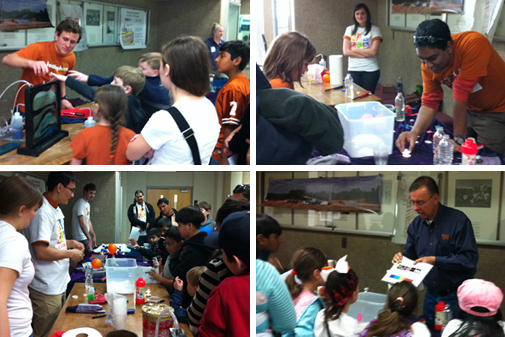
Ramon Trevino, Jiemin Lu, Mary Hinst, Kerstan Wallace, Julie Ditkof, Wylie Walker, and Zahid Khandaker entertain and educate during Explore UT.
February 21-22, 2013: UT Energy Forum 2013 Texas Energy Research Challenge. Julie Ditkof took first place for her poster "Analysis of time lapse seismic signal for an EOR and CCS site,Cranfield, MS." Sean Porse presented, "Using Analytical and Numerical Modeling to Assess the Utility of Groundwater Monitoring Parameters at Carbon Capture, Utilization, and Storage Sites." Austin, TX
February 19, 2013: Susan Hovorka and Tim Dixon have written a letter outlining the regulatory controls that limit risk of seismicity.
February 3-6, 2013: Society for Petroleum Engineers Applied Technology Workshop "Carbon Capture and Storage - Emphasis on Offshore Carbonate Reservoirs." Tip Meckel led discussion "Broader MMV Issues in Carbonates." Ian Duncan led discussions: "Site Selection for CCS in Carbonate Reservoirs," "Seabed Sensors and Shallow Sub-surface Marine Monitoring," and "Risks for Offshore Pipelines." Penang, Malaysia.
February 2, 2013: 2nd Annual Jackson School Student Research Symposium. A number of GCCC students participated in this annual day-long poster competitition designed to provide cross-disciplinary collaboration among graduate students, undergraduate students, and faculty/research scientists at the Jackson School. Congratulations to Kerstan Wallace for winning second place for late career masters student. He presented "Use of 3-Dimensional Dynamic Modeling of CO2 Injection for Comparison to Regional Static Capacity Assessments of Miocene Sandstone Reservoirs in theTexas State Waters, Gulf of Mexico" [PDF]. Mary Hingst presented "Effects of elevated CH4 and CO2 on the mobility of metals in near-surface sediments" [PDF]. Julie Ditkof presented "Time lapse seismic signal analysis for Cranfield, MS, EOR and CCS site" [PDF]. Sean Porse presented "Using Analytical and Numerical Modeling to Assess the Utility of Groundwater Monitoring Parameters at Carbon Capture, Utilization, and Storage Sites" [PDF]. Logan West presented "An investigation of the evolution and present distribution of residual oil zones (ROZ) in the Permian Basin, West Texas and its implications for carbon dioxide (CO2) storage" [PDF]. Javier Munoz Torres presented "Production Patterns in Eagle Ford Shale (Decline Curve Analysis)" [PDF]. Austin, TX
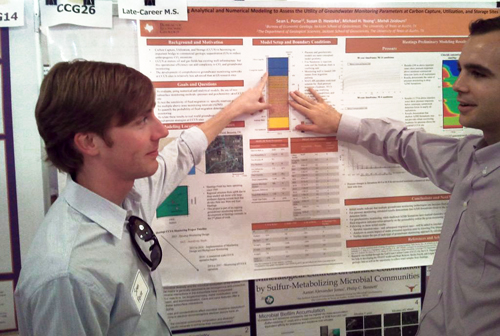
Sean Porse explains his research at the Jackson Student Symposium.
January 23, 2012: Tip Meckel and GCCC staff hosted a group from Department of Energy Systems Engineering, Seoul National University to discuss offshore monitoring. Austin, TX

Katherine Romanak speaking at the RITE CCS workshop in Tokyo.
January 20, 2013: RITE CCS Technical Workshop. Katherine Romanak gave invited talk, "Case study: a field survey in response to claims of CO2 leakage - Weyburn oil field." Tokyo, Japan
January 7-8, 2013: Progress Review of STAR Grant Research on Carbon Geosequestration. JP Nicot presented "Pressure-Anomaly Based Leakage Detection" and Susan Hovorka presented "Development of Site-specific Monitoring Approaches" at EPA Headquarters. Washington, DC.



